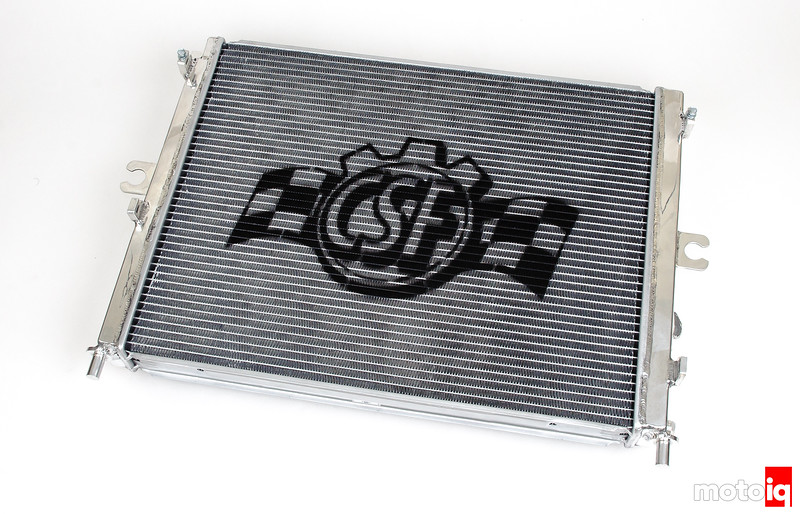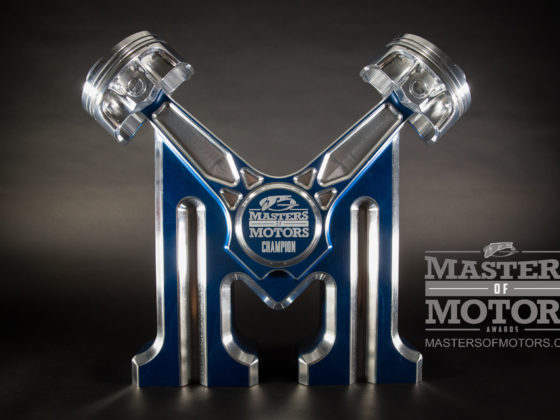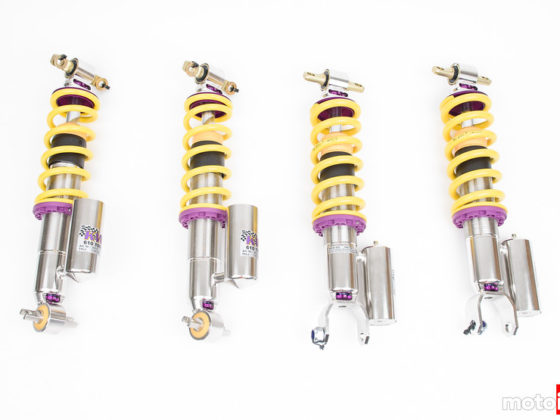Adding the gauge was sort of a last minute decision so we didn’t have a solution for mounting the gauge beyond a small bracket we asked for from Autometer. Upon examining locations in the car we couldn’t find a permanent place to mount the gauge quickly, so we temporally mounted it on the lowered glove compartment and secured it with blue painters tape.

After kicking around a few ideas about permanently mounting the gauge an a-pillar mount is what we’re probably going to end up doing. There isn’t a low location that doesn’t interfere with leg room and on the dash like the 370z factory gauges would prove difficult with wiring. We’ve got a little fusible link powering the gauge for the time-being until we can make the whole setup more permanent.

As far as engine coolant temps go, we took measurements before and after installing the CSF radiator. We collected our data towards the tail end of the Phoenix summer with 110 degrees as the ambient outside temperature. We recorded 201 degrees engine coolant temperature on the OE system with freshly flushed factory coolant. After the CSF radiator install we observed slightly cooler engine coolant temperatures on the same exact drive – 196 degrees.
I consulted chief nerd Mike Kojima for his engineering view on our results. His view is that 194 degrees is the full opening point of the thermostat. With the CSF radiator we’re running closer to the thermostat full opening point with an engine coolant temp of 196 vs. 201 degrees stock. I did a lot of back to back testing on the OE system and 201 degrees seemed to be the coolant temp even when the outside temp would go +/- 5 degrees in the extreme heat. Both before and after a coolant flush. We’ll be doing some more follow up tests to see how much ambient temp effects the coolant temp.
With an upgraded cooling system and a way to monitor our transmission temps, we are ready for the next step in our G37’s transmission upgrade. In our next article we will get into the detail of our Level 10 transmission upgrade and new engine and transmission tunes from UpRev.
Sources




8 comments
As somebody who used to be a Nissan tech that had to diagnose a G37X with the sport package added, leading an article with a radiator pic doesn’t confuse me in the slightest 😛
That being said, my Snap-On Modis Ultra can read the factory trans temp datastream faster than it takes for the OEM Nissan CONSULT3+ scantool to even manage to connect to the the ECU and allow you to choose which PID data to display on it, but I daresay that sending unit is a damned sight cheaper than a Modis Ultra. Kind of surprised UpRev doesn’t have any means of reading PID data via a connected PC?
When I asked Up-Rev about it they said the data for the transmission temps was encrypted but I assume all the data is encrypted but then you have to find what’s what and map the values. UpRev does have the oil temp because in part 2 when we had the car on the dyno it was going up pretty high 😀 before we had to stop tuning to let the temps drop. It seems the car needs all sorts of help in the cooling department if your doing anything beyond a normal commute and occasional stoplight or freeway onramp blast.
Be prepared to replace that radiator in 2 years. Koyo was supposed to be the go to but they don’t offer an ac condenser.
http://www.the370z.com/engine-drivetrain/70708-radiator-csf-mishimoto-17.html
We find CSF radiators to be high quality and long life.
Can only speak from our experiences, but our 370Z Project had the CSF radiator/condenser combo for a year and a half without a single issue. It was then outfitted with the CSF triple-pass radiator and that has been on the car since 2014 – also with zero issues. Here are the links to those articles:
https://motoiq.com/project-nissan-370z-keeping-it-cool-with-a-csf-radiator-hps-hoses-and-a-nissan-motorsports-oil-cooler/
https://motoiq.com/project-370z-heated-battle-testing-the-csf-triple-pass-radiator/
To measure the volume difference between the radiators, you could have plugged one end of each radiator, filled it up with water(measured) and compared.
Of course you cannot plug one end/side until full are you will not be able to fill it.🤔